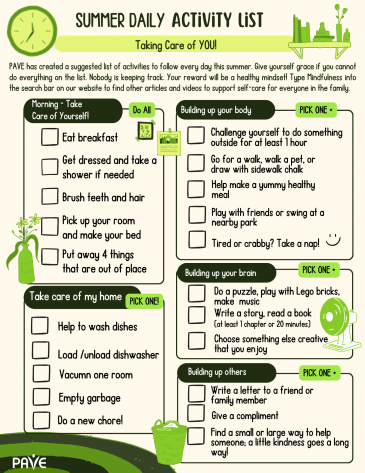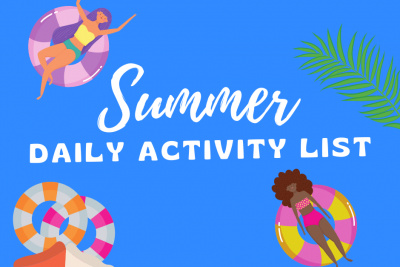- Self-care is not selfish. Self-care is any activity or strategy that helps you survive and thrive in your life. Without regular self-care, it can become impossible to keep up with work, support and care for others, and manage daily activities.
- PAVE knows that self-care can be particularly challenging for family members caring for someone with a disability or complex medical condition. This article includes tips and guidance especially for you.
- For a quick takeaway, here is a short video to inspire self-care today: Self Care for Caregivers.
- PAVE provides a library with more strategies to cultivate resilience, create calm through organization, improve sleep, and more: Self-Care Videos for Families Series.
Full Article
Raising children requires patience, creativity, problem-solving skills and infinite energy. Think about that last word—energy. A car doesn’t keep going if it runs out of gas, right? The same is true for parents and other caregivers. If we don’t refill our tanks regularly we cannot keep going. We humans refuel with self-care, which is a broad term to describe any activity or strategy that gives us a boost.
Self-care is not selfish! Without ways to refresh, we cannot maintain our jobs, manage our homes, or take care of people who need us to keep showing up. Because the demands of caring for someone with a disability or complex medical condition can require even more energy, refueling through self-care is especially critical for caregivers. This article is for you!
Before you read anymore, try this simple self-care tool called Two Feet, One Breath. Doctors use this one in between seeing patients:
- Notice your two feet on the ground. Feel the ground and feel your feet under you, with the weight of your body dropping into the ground through your feet. If you don’t stand on two feet, then notice whatever part of your body is connecting you to furniture or the floor.
- Notice that you are breathing in and imagine that breath starts in your feet (or seated body) and travels all the way to the top of your head.
- Notice that you are breathing out and imagine that your outbreath goes all the way down and out through your feet (or seated body).
Two Feet, One Breath can become part of every transition in your day: when you get out of bed or the car, before you start a task, after you finish something, or any time you go into a different space or prepare to talk with someone. This simple practice highlights how self-care can become integrated into your day.
Keep in mind: Although a day at the spa might be an excellent idea, self-care doesn’t have to be fancy or expensive to have a big impact!
These practices matter a lot, especially because almost everyone knows or cares for someone with special needs. According to the Centers for Disease Control (CDC), at least 26 percent of the population experiences a disability. The result is widespread compassion fatigue, which is a way to talk about burnout from giving more than you get.
Anyone who isn’t convinced that self-care matters may want to watch a film by National Geographic, Stress, Portrait of a Killer, which includes research data to show how caring for a child with special needs can impact parents (minute 38 includes that report).
Below are some ways to pull on your own oxygen mask first!
Connect with others
Meet up regularly with people who have similar life stressors. The Parent-to-Parent network can help by matching parents with similar interests or by providing regular events and group meetings.
Caregivers of youth who are Deaf or Hard of Hearing (DHH) can connect with other family caregivers at Washington Hands and Voices.
For caregivers of young people with behavioral health conditions, there are several family-serving agencies that might provide help and solidarity. Some agencies are listed at the end of this article and in PAVE’s Behavioral Health Toolkit.
Here are additional places to find one another:
- School
- Sports teams
- Community center
- Special Needs Parent Teacher Association
- Extracurricular events
- Online support groups
Get Enough Sleep
The body uses sleep to recover, heal, and process stress. If anxiety or intrusive thinking consistently interrupts sleep, self-care starts with some sleeping preparations:
Move the Body
Moving releases feel-good chemicals into the body, improves mood, and reduces the body’s stress response. Walk or hike, practice yoga, swim, wrestle with the kids, chop wood, work in the yard, or start a spontaneous living-room dance party.
Here is information from the Mayo Clinic about exercise:
- It pumps up endorphins. Physical activity may help bump up the production of your brain’s feel-good neurotransmitters, called endorphins. Although this function is often referred to as a runner’s high, any aerobic activity, such as a rousing game of tennis or a nature hike, can contribute to this same feeling.
- It reduces negative effects of stress. Exercise can provide stress relief for your body while imitating effects of stress, such as the flight or fight response, and helping your body and its systems practice working together through those effects. This can also lead to positive effects in your body—including your cardiovascular, digestive and immune systems—by helping protect your body from harmful effects of stress.
- It’s meditation in motion. After a fast-paced game of racquetball, a long walk or run, or several laps in the pool, you may often find that you’ve forgotten the day’s irritations and concentrated only on your body’s movements.
- It improves your mood. Regular exercise can increase self-confidence, improve your mood, help you relax, and lower symptoms of mild depression and anxiety. Exercise can also improve your sleep, which is often disrupted by stress, depression and anxiety. All of these exercise benefits can ease your stress levels and give you a sense of command over your body and your life.
Be Mindful
Mindfulness can be as simple as the Two Feet, One Breath practice described at the top of this article. Mindfulness means paying attention or putting your full attention into something.
Focusing the mind can be fun and simple and doesn’t have to be quiet. Here are a few ways to practice that don’t involve a yoga mat or a meditation cushion:
- Color
- Work on/wash the car
- Build something
- Make art or do a craft project
- Put together a puzzle
- Laugh
- Clean
- More ideas: Mindful.org
Schedule Time
A day can disappear into unscheduled chaos without some intentional planning. A carefully organized calendar, with realistic boundaries, can help make sure there’s breathing room.
Set personal appointments on the calendar for fun, dates with kids, healthcare routines, and personal “me time.” If the calendar is full, be courageous about saying no and setting boundaries. If someone needs your help, find a day and time where you might be able to say yes without compromising your self-care. Remember that self-care is how you refuel; schedule it so you won’t run out of gas!
One of PAVE’s self-care videos for families is this one: Get Calm by Getting Organized.
Here’s more guidance: calendar.com: Why Stress Management and Time Management go Hand in Hand.
Seek Help
Respite care provides temporary relief for a primary caregiver. In Washington State, a resource to find respite providers is Lifespan Respite. PAVE provides an article with more information: Respite Offers a Break for Caregivers and Those They Support.
Parents of children with developmental disabilities can seek in-home personal care services and request a waiver for respite care from the Developmental Disabilities Administration (DDA). Here are resources to help with that process:
For parents whose children and youth experience conditions related to behavioral health, PAVE provides a toolkit with resources for navigating crisis systems, medical care, school, and family support networks. Here are some family serving agencies:
Parents of youth who are blind or low vision may seek support from the Washington State Department of Services for the Blind (DSB). Learn from youth at PAVE: My story: The Benefits of Working with Agencies like the Washington State Department of Services for the Blind.
Parents of youth who are Deaf or Hard of Hearing (DHH) can connect with the Office of the Deaf and Hard of Hearing | DSHS or connect with other family caregivers at Washington Hands and Voices.


